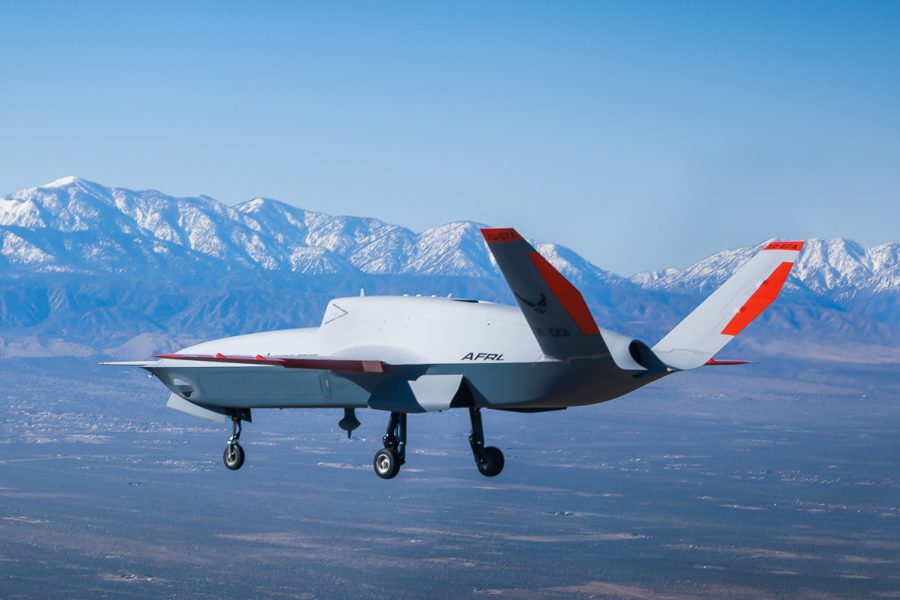The Air Force released the first video of a new experimental drone in flight on June 26, offering a potential preview of the service’s future fleet of autonomous collaborative combat aircraft.
Air Force Research Laboratory published a 90-second clip of General Atomics XQ-67A’s inaugural flight, which occurred in February at the company’s Gray Butte facility in Palmdale, Calif. General Atomics, the Air Force’s main drone manufacturer for the past 30 years, was awarded one of two design contracts for the first autonomous collaborative combat aircraft (CCA) in April. The company called the XQ-67A a “CCA prototype” when it won the contract.
The XQ-67A is part of the Air Force Research Laboratory’s Low-Cost Attritable Aircraft Platform Sharing (LCAAPS) program to test a so-called Off-Board Sensing Station (OBSS), which is exploring data-sharing technologies hosted on an autonomous drone. The aircraft is piloted remotely but capable of autonomous flight. It is the Air Force’s follow-up to Kratos’s XQ-58A Valkyrie, which was originally developed under the USAF’s Skyborg autonomous aircraft program and is now being tested by the U.S. Marine Corps.
General Atomics said in a release April 24 that the XQ-67A had completed three test flights since its first takeoff on Feb. 28. The company has trumped the aircraft as a preliminary version of a CCA.
“This program focused on building several aircraft variants from a common core chassis,” General Atomics, also known as GA-ASI, said in a release after being awarded the CCA Increment 1 design contract. “Since then, this prototype for CCA has successfully completed two additional test flights, laying the groundwork for a successful production and flight test program. GA-ASI’s CCA production representative design is based upon the XQ-67A Off-Board Sensing Station developed by GA-ASI for the AFRL.”
The Air Force is also testing out its autonomous technology, in part, on the X-62 VISTA, a modified F-16. Secretary of the Air Force Frank Kendall rode in an AI-piloted VISTA last month in simulated dogfights against a human pilot.
“Designed, built, ground tested, and flown in just over two years, AFRL’s XQ-67A builds on the success of the XQ-58A Valkyrie and complements the Air Force Test Center’s X-62 VISTA and F-16 VENOM efforts to speed fielding of Collaborative Combat Aircraft, or CCA,” ARFL said in its release.
The Air Force leaders say their intent is to move at the pace of technology and not fall behind by developing CCAs as traditional aircraft programs.
“As we’re looking at leaning into human-machine teaming and developing these collaborative combat aircraft, we’re trying to do three things in parallel, which sometimes we had done serially,” Air Force Chief of Staff Gen. David W. Allvin said in May. “We developed a platform … and then afterwards, we’ll figure out how we’re going to do the rest of DOTMLPF [doctrine, organization, training, materiel, leadership and education, personnel, and facilities] spectrum, and how we’re going to actually employ it and how we’re going to base it, etcetera. We’re doing those all at once now.”
Allvin doubled down on those comments earlier this month at an AFA Warfighters in Action event, noting the Air Force is making “big bets” on human-machine teaming, which was informing how the service thought other types of aircraft, not just drones. He said the service was thinking through how it might use and perhaps discard particular CCA technologies in as little as a decade rather than follow a model based on traditional aircraft programs that span may span 30 years or more.
The XQ-67 is based on a similar philosophy.
“This provides an alternate acquisition approach for ACP [autonomous collaborative platforms] aircraft using a product line philosophy that enables faster development, lower costs, and opportunities for frequent technology refreshes,” AFRL said in its release.
